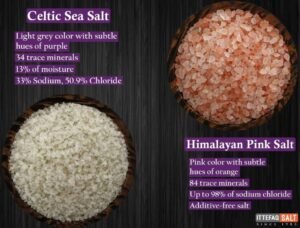Celtic Vs Himalayan Salt: Health Benefits You Need To Knowa
The consumption of salt is an integral part of our daily lives and plays a crucial role in maintaining a healthy lifestyle. However, not all salt is created equal. Celtic and Himalayan salt are two popular options known for their distinct mineral composition and potential health benefits. In this blog, we will compare and analyze the health benefits associated with Celtic salt and Himalayan salt, taking into consideration their origin, mineral content, and potential impact on our overall well-being.
Origin and Extraction Process:
Celtic salt, also known as sel gris, comes from the coastal regions of France, where it is harvested through an ancient technique by evaporating sea water in large clay basins. On the other hand, Himalayan salt is extracted from the Khewra Salt Mine in the Punjab region of Pakistan, formed millions of years ago from ancient sea deposits. Both salts are considered naturally sourced and free of synthetic additives.
Mineral Composition and Nutritional Profile:
Celtic salt is celebrated for its robust mineral content, including essential elements such as calcium, magnesium, potassium, and iron. These minerals are believed to provide numerous health benefits, ranging from supporting bone health to enhancing electrolyte balance. Himalayan salt, often referred to as pink salt due to its characteristic hue, contains similar essential minerals, but in slightly different concentrations. Additionally, it is rich in trace minerals like copper, zinc, and selenium, which are essential for various biological processes in the body.
Digestive Health and Electrolyte Balance:
Both Celtic and Himalayan salt can promote healthy digestion and aid in maintaining an optimal electrolyte balance. Celtic salt, with its higher magnesium content, may aid in reducing inflammation in the gastrointestinal tract and improving digestive issues. Himalayan salt, on the other hand, is believed to support proper pH balance and help prevent acid reflux by providing the necessary trace minerals for optimal digestion.
Hydration and Mineral Absorption:
Proper hydration and mineral absorption are vital for overall health. Celtic salt, due to its mineral-rich composition, is considered beneficial for improving hydration and enhancing the body’s ability to absorb nutrients from food. Similarly, Himalayan salt can aid in optimal hydration by promoting cellular water absorption, thereby supporting various bodily functions.
Cardiovascular Health and Blood Pressure Regulation:
Maintaining a healthy blood pressure level is crucial for cardiovascular well-being. Celtic salt, being lower in sodium content compared to regular table salt, may be beneficial for individuals concerned about blood pressure. The presence of other essential minerals in Celtic salt, such as potassium, can also help regulate blood pressure levels effectively. Himalayan salt, with its balanced mineral profile, can also contribute to maintaining optimal cardiovascular health.
Respiratory and Sinus Health:
Both Celtic and Himalayan salt have been used for centuries in traditional remedies to improve respiratory and sinus health. Celtic salt’s mineral combination, particularly its magnesium content, may help reduce inflammation in the airways and alleviate respiratory conditions such as asthma and allergies. Similarly, Himalayan salt’s inhalation therapy, commonly known as salt therapy, has gained popularity for its potential benefits in alleviating sinus congestion, bronchitis, and other respiratory discomforts.
Skin Health and Detoxification:
The mineral content found in Celtic and Himalayan salt can be beneficial for skin health and detoxification. The minerals in Celtic salt are believed to promote skin hydration, improve circulation, and aid in the removal of toxins, resulting in a healthier complexion. Similarly, Himalayan salt is often used in bath salts to exfoliate and cleanse the skin, reducing inflammation and promoting detoxification.
Celtic salt and Himalayan salt both offer unique health benefits due to their distinctive mineral composition. While Celtic salt is celebrated for its high mineral content and potential benefits for digestive health and electrolyte balance, Himalayan salt is known for its trace mineral profile and its potential positive impact on cardiovascular health, skin health, and respiratory wellness. Ultimately, choosing between the two salts becomes a matter of personal preference and individual health goals, as both provide valuable nutrients and can be incorporated as part of a healthy lifestyle.


Comments